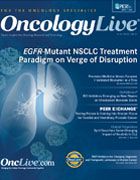Publication
Article
Oncology Live®
PARP Inhibitors Are Changing Diagnostic and Therapeutic Landscape in Ovarian Cancer
Author(s):
PARP inhibitors are the most commonly used targeted therapy for patients with recurrent ovarian cancer, and the indications for the use of these drugs have broadened in recent months.
Lisa M. Barroilhet, MD

Lisa M. Barroilhet, MD
Assistant Professor, Medicine
Dolores A. Buchler, MD Faculty Fellow in Gynecologic Oncology
UW Carbone Cancer Center
University of Wisconsin School of Medicine and Public Health
Targeted therapy in ovarian cancer is a relatively new field, and one that is rapidly expanding. PARP inhibitors are the most commonly used targeted therapy for patients with recurrent ovarian cancer, and the indications for the use of these drugs have broadened in recent months. Their popularity has increased as newly reported study findings support their efficacy and because of their oral bioavailability and convenient dosing schedule.
PARP inhibitors block the enzyme poly (ADP-ribose) polymerase, causing multiple doublestrand DNA breaks to form in patients who have homologous recombination deficiency (HRD). The best-known HRD pathway proteins are BRCA1 and BRCA2, which are encoded by t u mor - suppr e ssion genes that can harbor germline mutations. BRCA-related ovarian cancers make up about 15% of all ovarian cancers diagnosed in the United States, and the genes are most commonly altered in patients with familial breast and ovarian cancer syndromes. Patients with BRCA mutations have up to a 60% lifetime risk of developing ovarian cancer.
Figure. PARP Inhibition in Action
Impact of FDA Approvals
Tumors with BRCA mutations are particularly susceptible to double-strand DNA breaks. In the presence of a PARP inhibitor, repair of DNA damage, which is an expected part of any cell cycle, cannot be performed efficiently and tumor cells die (Figure). Normal cells that do not replicate their DNA as frequently as cancer cells do and that lack BRCA abnormalities survive PARP inhibition. This means that some of the most frustrating adverse effects of traditional chemotherapy, such as hair loss, are avoided.There are 3 PARP inhibitors on the market that are approved for the treatment of patients with ovarian cancer: olaparib (Lynparza), rucaparib (Rubraca), and niraparib (Zejula).
The FDA approved olaparib in December 2014 for use in patients with suspected or confirmed BRCA-mutated advanced ovarian cancer who have been treated with 3 or more prior lines of chemotherapy. A phase III clinical trial accruing at UW Carbone Cancer Center and centers throughout the United States is examining olaparib with and without cediranib, a potent inhibitor of vascular endothelial growth factor receptor tyrosine kinases, compared with standard platinum-doublet chemotherapy (NCT02446600). This is the largest multiarm prospective trial examining the efficacy of olaparib paired with other targeted therapy.
Rucaparib was approved in December 2016 for patients with confirmed somatic or germline BRCA mutations who have been treated with 2 or more prior lines of chemotherapy. Testing of tumor tissue in the recurrent setting in order to identify a potential somatic BRCA mutation is now becoming commonplace, while it was rarely performed prior to rucaparib’s approval.
In March 2017, following a report in the New England Journal of Medicine,1 niraparib was approved for maintenance treatment of patients with recurrent ovarian cancer who meet the common definition of platinum sensitivity. This is the first FDA-approved maintenance therapy for ovarian cancer and has the potential to change standard practice.
Unanswered Questions
In general, PARP inhibitors are well tolerated. Common toxicities include anemia, nausea, and fatigue. Myelodysplastic syndromes are seen in up to 2% of patients treated with these medications, and patients should be appropriately counseled regarding this adverse effect.PARP inhibition may be beneficial outside of BRCA-positive patients. The study findings that led to niraparib’s FDA approval for all platinum-sensitive patients show improved survival in patients with and without known BRCA mutations (Table).1 This raises questions about larger implications for other mutations in genes associated with HRD, including PALB2, BRIP1, CHEK2, RAD51C, and RAD51D. Potentially, abnormalities in these genes could be markers for platinum sensitivity.
Table. Efficacy Findings in Pivotal Niraparib Trial1
As we enter this new landscape of precision medicine in ovarian cancer, we must be prepared to offer these therapies to our patients at various points during their treatment course, which often extends over years. We know little about using a different PARP inhibitor after the first has failed. The optimal timing of screening for somatic BRCA mutations has not been defined. One could argue that biopsy at the time of recurrence would be the most accurate; however, many patients do not have disease amenable to core biopsy. Until more is known, many providers rely on tissue from the original cancer debulking surgery.
Further, although the Society of Gynecologic Oncology recommends genetic counseling and genetic testing for all patients with ovarian cancer, only about half of eligible patients have BRCA testing results available at the time of cancer recurrence. There are many opportunities here to enrich the care of patients battling recurrent ovarian cancer. PARP inhibitors have opened the door to the potential of targeted therapy in treating this challenging disease.
Mirza MR, Monk BJ, Herrstedt AM, et al; ENGOT-OV16/NOVA Investigators. Niraparib maintenance therapy in platinum-sensitive, recurrent ovarian cancer. N Engl J Med. 2016;375(22):2154-2164. doi: 10.1056/NEJMoa1611310.










